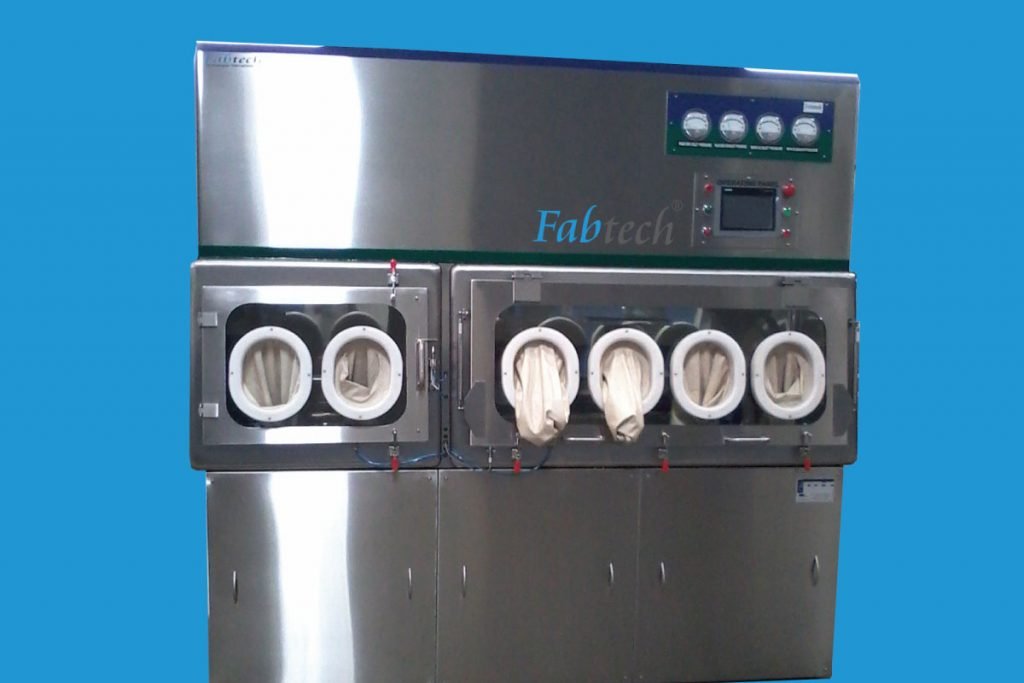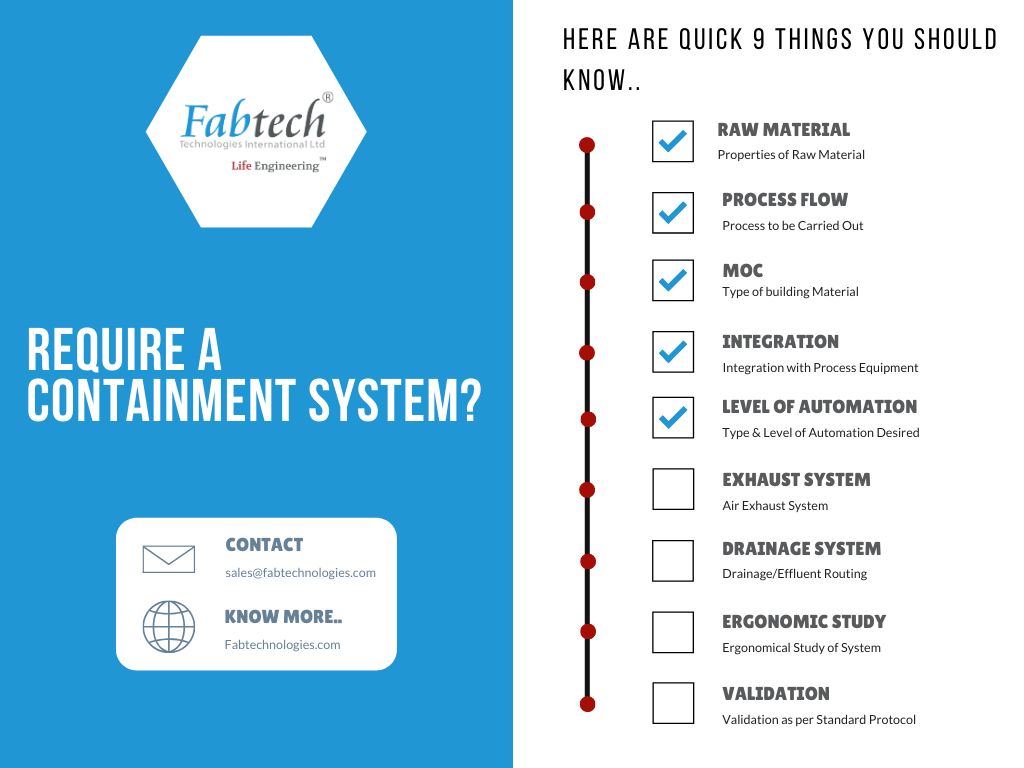Our tips on selecting the right containment system for pharma

To keep employee exposures within acceptable limits and to protect the environment while containing costs, pharmaceutical companies and their contract partners who manufacture and handle high-containment compounds must carefully select their containment equipment.
We have outlined the points to consider when choosing the right containment system.

1) RAW MATERIALS
The properties of basic materials being processed play a key role in choosing the containment system. Occupational Exposure Level (OEL), as well as the physical and chemical properties of the materials, must be considered carefully.
Some materials require special care while Handling & Processing; for example, APIs used for new products are increasingly becoming more potent. Thus Containment systems should be able to secure the production area also while maintaining some specific environment when working with these particular compounds (such as specific RH, Temperature, etc).
2) PROCESS FLOW & REVIEW
Document the process flow in detail and conduct a containment review for each step involved in the process including the quantity of material being handled:
- Material IN
- Material OUT
- Manipulation
- Decontamination
Material transfer from one process step to another process step in a contained manner must be appropriate to OEL level.
Decontamination method & procedure must be well defined for process equipment and containment system.
3) MATERIAL OF CONSTRUCTION (MOC)
For Rigid Systems,
MOC is SS316 L. The gasket and manipulative device material must be FDA compliant and compatible with molecules being processed. Standard electrical execution is NFLP (non-flame proof). However, FLP execution is recommended for solvents and depending on the characteristics of molecules being handled.
For Flexible Systems,
MOC is PU based. Risk assessments determine which manipulative devices and gaskets are utilized. The entire system is intended for single use.
4) INTEGRATION
Process equipment integrated with the containment system must also be compatible. A detailed engineering study is performed to ensure airtight integration with the containment system. A study is conducted to evaluate the feasibility of each manipulation as well as an evaluation of the decontamination and cleaning process. There must be a seamless integration of mechanical, electrical and control systems of process equipment and the containment system.
5) LEVEL OF AUTOMATION
The focus of containment solutions has been the safety of products and operators by controlling exposure of high potent substances or curbing contamination. The speed of technological change that is sweeping across industries and businesses is electrifying. One of the ways of improving efficiency is reducing or eliminating human intervention. The control system used for both Containment and Process Equipment must work in harmony, thus to avoid a different set of instructions for each of the equipment.
There can be countless combinations to create the control system; however, it can be summed up using either of these factors –
- HMI PLC based Control System; A simple touch-based control system to control mostly single equipment.
- SCADA based Control system; A control system with varied functions to control multiple equipment/processes simultaneously.
6) EXHAUST SYSTEM
One of the most essential details to look into for an Isolator, irrespective of the level that helps control particle contamination is the Exhaust air system, especially when the necessary level of containment is 1µg of the potent compound per cubic meter of air.
The internal airflow of a barrier/isolator designed for containment should allow clear viewing of the operation and removal of any heat generated by the process equipment contained in the system. The decision to recirculate or throw away the air is a function of any special atmosphere requirements. If low humidity or inert atmosphere is required, the system should be re-circulated to reduce cost.
The exhaust requires filtration to capture the potent materials before release of the airstream.
7) DRAINAGE SYSTEM
Another critical area of an Isolator is the Drainage system. The drainage systems have to be disposed appropriately.
The Isolator is made mostly with a sloped floor to the drain and has a good visibility in the drain area. Manual spray guns with a hose or fixed stainless steel piping with spray balls are provided to clean the chamber. (Only reframed the earlier sentence)
A floor drain with a valve allows the safe disposal of liquid waste. Alternatively to the use of the spray gun to avoid liquid waste, cleaning cloths soaked with alcohol can be used.
The waste water is drained through a bottom seat valve into the waste water collection tank and afterward discarded.
8) ERGONOMICS STUDY
An Ergonomics Study is conducted with a replica of the Containment System. Extensive tests are performed to ensure everything is in line with the actual operations. Once this is completed a final 3D drawing is prepared, and the manufacturing process begins.
9) VALIDATION
Process equipment is validated as per standard protocol. However, for containment systems a combined validation of process equipment and containment system is also conducted including:
- Leak testing of the entire system. (This is a crucial test.)
- Air cleanliness level which includes HEPA integrity testing, velocity profile and particle count
- Sound levels
- Light intensity
- Drainability
- Process equipment interlocking with the containment system
Once the system is commissioned, OEL validation is conducted using surrogate materials to validate the entire system design. This is a onetime exercise performed by certified hygiene professionals in close coordination with the end user and results are independently certified for OEL exposure.
Fabtech’s Containment Systems can be used for tablet and capsule manufacturing, injectables, APIs and customised solutions. Our Life Engineers are here to assist you with any further information. Use the form below to request more information about our Containment Systems.
Categories
Recent Posts
Subscribe
Never miss a post from Fabtech. Sign up to receive updates direct to your inbox.
